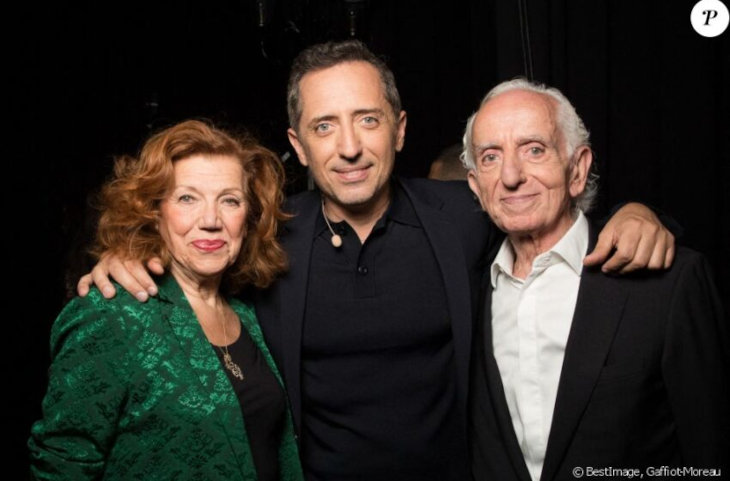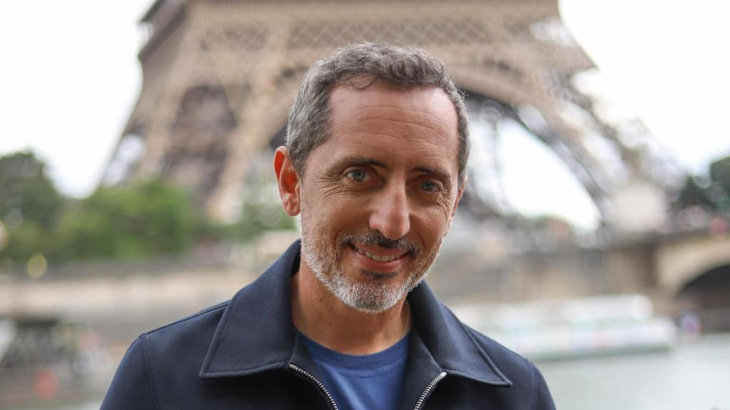 Vampire Weekend's Surprising Jewish Stories
Vampire Weekend's Surprising Jewish Stories


7 min read
And why he doesn’t have to.
Gad Elmaleh, France’s most popular Jewish comedian, who has often referenced his Jewish identity onstage, has shocked the Jews of France and his fans world-wide by announcing that he is converting to Catholicism. Think how Americans would feel if Jerry Seinfeld—or Barbra Streisand—converted to Catholicism.
Gad (a Hebrew name, one of the twelve sons of the Patriarch Jacob) was born in Casablanca to traditional Moroccan Jewish parents. He attended Jewish school. At the age of 17, he emigrated with his family to Canada, and later moved to Paris. He was voted the “funniest man in France” and has been nominated for the French equivalent of an Oscar. His comedy sketches in English are popular on Netflix.
So why is he converting to Catholicism?
Could it be the influence of his three Catholic romantic partners, including Charlotte Marie Casiraghi, a princess from the royal family of Monaco? Although he fathered children with two of these women, he has never married.
Could it be rebellion? In an interview on French television he told how, at the age of six in Casablanca, he, with his father and sister, walked past a church. His father told him, “You see this building? You do not enter there.” Gad recounted that he was “tempted” by the forbidden. He and his sister later stole into the building. The statue of the Virgin Mary “floored” him. He was also awed by the quiet and “calmness” of the cathedral, contrasted to the loud prayers of a Moroccan synagogue.
Could it be psychological, acting out his complicated relationship to his own mother? When the television interviewer asked Gad, “What do you have from your mother?” he replied, “Everything.”
Gad’s parents are horrified by his decision. Moroccan Jews are descendants of Spanish Jews who, faced with the Edict of Expulsion of 1492, chose to relinquish all their property and to risk death at the hands of pirates or unscrupulous sea captains by leaving Spain, rather than convert to Christianity.
 Gad and his parents
Gad and his parents
Gad asked his parents to appear in a film he was making about a Jew who converts to Christianity. On camera, he revealed to them that he is that Jew. His mother, unscripted, exclaimed, “‘You’re changing your God, so you may as well change your parents.”
All conjectures aside, Gad himself said his decision is for spiritual reasons.
Gad, raised in a traditional Jewish home, never realized that he could have such a personal, loving relationship with the God of Judaism.
He explained that when he first saw that statue in the church at the age of six, he “fell in love at first sight.” Later, the “Virgin Marie took me under her wing.”
He recounts that he gradually began asking the Virgin Mary to help him, “especially before shows” when he apparently felt anxiety, and he experienced a response.
The irony is that Gad, raised in a traditional Jewish home, never realized that he could have such a personal, loving relationship with the God of Judaism.
Moroccan Jews are known to uphold Jewish tradition. Gad Elmaleh likely grew up in a home imbued with Jewish heritage. His attraction to Christianity is a jarring reminder that the shelf life of Judaism-as-tradition pales in comparison to Judaism-as-a-relationship-with-God.
The God of Judaism is formless but not abstract, transcendent but also immanent, cosmic but also personal.
In the ancient world, rife with worship of various deities who were powerful in their specific realms and personalized in a multitude of forms, Abraham, the first Jew, taught about the existence of an all-powerful, formless God with whom he had a loving, personal relationship. God called him, “Abraham, who loves Me.”
Judaism rejects not only the truth of any embodiment of God, but also the need for it. Yet, human beings crave form. How can they have a relationship with a formless God?
The God that Judaism introduced to the world cannot be seen, but can be heard. At Mt. Sinai, God revealed Himself through the spoken word. God introduced Himself to the entire Israelite nation in the Ten Commandments as the God who intervenes in history for their benefit.
This is not a distant divine power. This is a personal God who loves us and saves us, not only in the mega events like the Exodus, but also in the daily challenges of our individual lives.
At the same time, God is transcendent, larger than the cosmos, beyond time and space, infinite. How can both be true?
Judaism has different names for God, referring to different aspects of the Infinite as revealed to human beings. Two names are used in every blessing, where God is addressed both as Y-H-V-H and as Elokim. Y-H-V-H represents God as transcendent, all-loving, and all-merciful. Elokim represents God in nature, in the nitty-gritty of life, behind both the unexpected check in the mail and the washing machine that breaks down. God has no concrete form, but He manifests in our life in concrete ways. Recognizing the “hidden God” is the challenge of Jewish life.
Personal prayer means speaking to God in your own words, in your own language, expressing both your needs and your gratitude to the One who supplies those needs. Throughout Jewish history, Jews have had an intimate relationship with God through personal prayer. Moses, when his sister Miriam was stricken with leprosy, prayed, “Please, God, heal her.” King David poured out his heart spontaneously to God in what have become known as the Psalms of David. We read those psalms from a book, but David forged them from his heart.
Personal prayer means speaking to God in your own words, in your own language, expressing both your needs and your gratitude.
Yet, after the destruction of the Temple, the sages composed set prayers to be recited three times a day. For most Jews thereafter, the formal prayers of the siddur replaced personal prayer rather than augmenting it.
This gave rise to the unfortunate phenomenon of “praying by rote,” in which Jews speak to God like they are speaking to an answering machine. The greatest sage of the 20th century, known as the Chafetz Chaim, wrote:
It is not enough that [one] prays the Shemoneh Esrai prayer three times each day; several times daily he must pour out his requests in solitude, in his house, from the depths of his heart. The three regular prayers are so routine that one does not really concentrate during them—which is not the case if each person would contemplate in solitude his own plight…. Then he would pour out his heart like water to God.
A word of warning: God doesn't like whining. So when you speak to God in personal prayer, start with thanking God for everything you have before you appeal to Him for what you lack.
A person whose business is failing or who is facing a health crisis or whose love life is floundering or who is nervous before going on stage can speak to God, with the faith that God has the ability to turn around every situation. The product of such reaching out is not always a miraculous rescue (although sometimes it is), but is always the forging of an intimate relationship with the God who loves you and does what is ultimately best for you. Without statues or pictures, a Jew can feel God’s loving presence in his or her life.

The television interviewer asked Gad: “What’s Jewish about you? One word.” Gad replied, “Esprit,” the spirit. Although often obscured by more mundane passions, the Jewish soul longs for an intimate relationship with God.
The Divine is beckoning to you, Gad, but you don’t need an intermediary. You can go direct.

As a lapsed Catholic his actions make no sense to me.